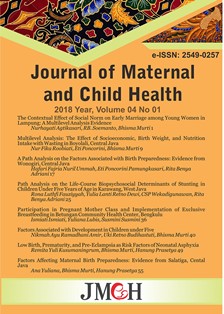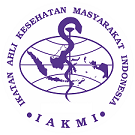The Contextual Effect of Social Norm on Early Marriage Among Young Women in Lampung: A Multilevel Analysis Evidence
Abstract
Background: Early marriage
References
Akhondali Z, Dianat M, Radan M (2015). Predictors of intention to marriage based on theory of planned behavior among university students in Iran. Electronic Physician, 7(1): 971
Badan Pusat Statistik (2016). Kemajuan yang Tertunda: Analisis Data Perkawinan Usia Anak di Indonesia. Jakarta.
Bandura A (2002). Social cognitive theory in cultural context. Applied Psychology, 51(2), 269
Bhanji SM, Punjani NS (2014). Determinants of Child (Early) Marriages among Young Girls: A Public Health Issue. J Women
BPS Indonesia (2018). Nikah, Talak dan Cerai, serta Rujuk, 2012
Delprato M, Akyeampong K, Sabates R, HernandezFernandez J (2015). On the impact of early marriage on schooling outcomes in Sub-Saharan Africa and South West Asia. International Journal of Educational Development, 44, 42
Godha D, Hotchkiss DR, Gage AJ (2013). Association between child marriage and reproductive health outcomes and service utilization: A multicountry study from south asia. Journal of Adolescent Health, 52(5), 552
Hotchkiss DR, Godha D, Gage AJ, Cappa C (2016). Risk factors associated with the practice of child marriage among Roma girls in Serbia Health and human rights of marginalized populations. BMC International Health and Human Rights, 16(1), 1
Husna N, Demartoto A, Respati S (2016). Factors Associated with Early Marriage in Sleman, Yogyakarta. Journal of Health Promotion and Behavior, 1(2), 87
Indonesia Ministry of National Development Planning and the United Nations Children
Komnas Perempuan Indonesia (2016). Kekerasan terhadap Perempuan Meluas: Negara Urgen Hadir Hentikan Kekerasan terhadap Perempuan di Ranah Domestik, Komunitas dan Negara. Jakarta.
McClearySills J, Hanmer L, Parsons J, Klugman J (2015). Child Marriage: A Critical Barrier to Girls
Montazeri S, Gharacheh M, Mohammadi N, Alaghband Rad J, Ardabili EH (2016). Determinants of Early Marriage from Married Girls
Nasrullah M, Zakar R, Zakar MZ (2014). Child marriage and its associations with controlling behaviors and spousal violence against adolescent and young women in Pakistan. Journal of Adolescent Health, 55(6), 804
Pandya YP, Bhanderi DJ (2015). An epidemiological study of child marriages in a rural community of Gujarat. Indian J Community Med, 40(4), 246
Pengadilan Tinggi Agama Bandar Lampung. (2016).
Republik Indonesia (1974). Undang-undang Republik Indonesia Nomor 1 Tahun 1974 Tentang Perkawinan. Lembaran Negara Republik Indonesia 1974. Jakarta: Sekretariat Negara. Retrieved from http://luk.staff.ugm.ac.id/atur/UU11974Perkawinan.pdf
Roy TK (2008). Determinants of Early Marriage in Rajshahi, Bangladesh. Pakistan Journal of Social Science, 5(6), 606
Sulaeman ES (2016). Pembelajaran Model dan Teori Perilaku Kesehatan Konsep dan Aplikasi.
Vogelstein R (2013). Ending Child Marriage: How Elevating the Status of Girls Advances U.S. Foreign Policy Objectives.
Wijayati NA, Soemanto RB, Pamungkasari EP (2017). Socioeconomic and Cultural Determinants of Early Marriage in Ngawi, East Java: Application of PRECEDE-PROCEED Model. Journal of Health Promotion and Behaviour, 2(4), 302
Workineh S, Kibretb GD, Degu G (2015). Determinants of Early Marriage among Female Children in Sinan District, Northwest Ethiopia. Journal, Health Science, 9(6), 1
World Health Organization (2016). Child, early and forced marriage legislation in 37 AsiaPacific countries. Retrieved from http://www.who.int/reproductivehealth/publications/gender_-rights/cefm-asia-pacific/en/





